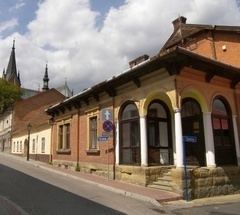Postal code 33-190 Area 9.99 km² Population 2,378 (2006) | Time zone CET (UTC+1) Car plates KTA Local time Monday 10:30 AM | |
 | ||
Weather 8°C, Wind W at 8 km/h, 79% Humidity | ||
Ciężkowice [t͡ɕɛ̃ʂkɔˈvʲit͡sɛ] (German: Hardenberg) is a town in Tarnów County, Lesser Poland Voivodeship, Poland, with 4,322 inhabitants (2010). It lies in the Ciężkowice Foothills, on the Biała river. The town is located on regional road nr. 977, it also has a rail station (Bogoniowice - Ciężkowice), on a line which goes from Tarnów to the Slovak border crossing at Leluchów. Ciężkowice is home to a sports club Ciężkowianka, founded in 1948.
Contents
Map of Ci%C4%99%C5%BCkowice, Poland
The history of Ciężkowice dates back to the year 1125, when in a document of Papal legate Gilles de Paris, the village is mentioned as a property of the Tyniec Benedictine Abbey. On February 29, 1348, King Kazimierz Wielki granted it Magdeburg rights town charter. At that time, Ciężkowice was inhabited by the German settlers (see Walddeutsche), and German language name of the town, Hardenberg was also used in documents. In the late Middle Ages, Ciężkowice was located on a merchant route from the Kingdom of Hungary to Kraków. Weekly fairs took place here every Wednesday, where local dairy products, clothes, salt, horses and Hungarian wines were sold. In 1358, St. Andrew parish church was built.
After the Swedish invasion of Poland, Ciężkowice lost its importance. Until 1772 (see Partitions of Poland), the town belonged to Sandomierz Voivodeship. From 1772 to late 1918, it was part of Austrian Galicia. The decline of Ciężkowice was so severe that in 1934, the government of the Second Polish Republic stripped it of the town charter, and Ciężkowice remained a village until 1998.
Points of interest
Stone Town Nature Reserve
Stone Town Nature Reserve (known in Polish as Rezerwat przyrody Skamieniałe Miasto) is located on the right bank of the Biała river, near Ciężkowice. It has the area of 15 hectares, and it was created in 1931, with official recognision in 1974. The reserve spreads from the Biała valley to the peak of the Skała hill (367 meters above sea level). Among oak and pine forest there are several large sandstone rocks, shaped during the process of erosion. Altogether, they make the so-called stone town, and names of individual rocks are based on their appearance (“Pyramid”, “Witch”, “Town Hall”, “Club”). There also is a small waterfall nearby.
